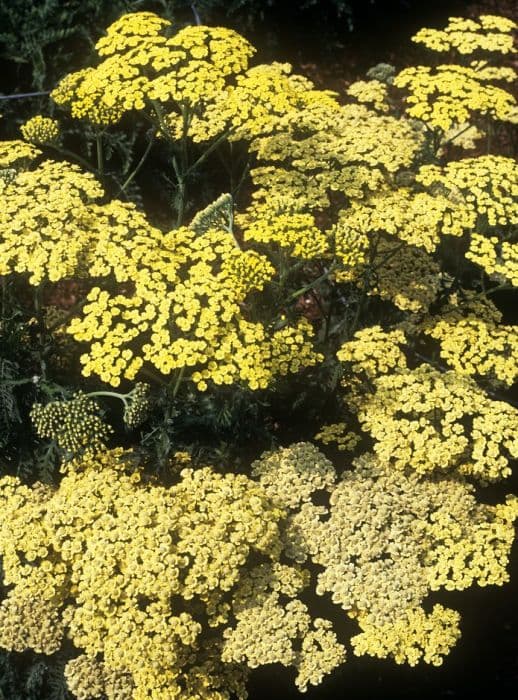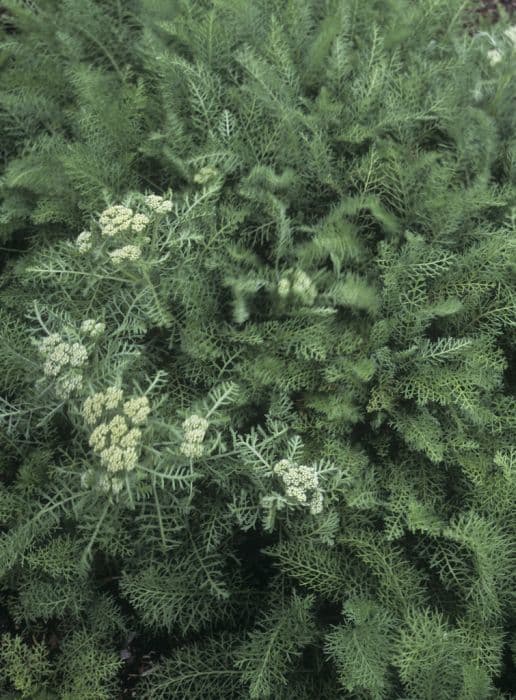Marigold Tagetes 'Zenith Red' (Zenith Series)

ABOUT
Tagetes 'Zenith Red', commonly known as a marigold in the Zenith Series, showcases a vibrant display of warm-toned flowers. Its blossoms are a captivating red hue, often with undertones or highlights that can range from a deep, rich crimson to a fiery, more orange-tinged red. The flowers are typically double and pom-pom-like, with numerous layers of petals that create a lush, full appearance. The leaves of the Zenith Red marigold are deep green, with a ferny texture that provides a perfect contrast to the intensity of the red flowers. They are slightly elongated and may have edges that appear finely serrated or lightly scalloped. Overall, the marigold presents a bushy and robust form, with a generous coverage of both foliage and blooms that contribute to its vivid display within a garden setting. As it blooms, Tagetes 'Zenith Red' becomes a beacon of color, attracting the gaze of admirers, as well as pollinators like butterflies and bees. The marigold's scent is distinctive, often described as pungent or musky, which contributes to its ability to repel certain garden pests. This combination of visual and olfactory characteristics makes the Zenith Red marigold not only an attractive choice for gardeners but also a practical one for companion planting.
About this plant
 Names
NamesFamily
Asteraceae.
Synonyms
African Marigold, French Marigold, Mexican Marigold.
Common names
Tagetes erecta 'Zenith Red'.
 Toxicity
ToxicityTo humans
Marigold is generally considered non-toxic to humans. However, some people may experience allergies or skin irritation when in contact with the plant. Ingesting large quantities of marigold could potentially lead to gastrointestinal discomfort, nausea, vomiting, or dizziness, but this is rare.
To pets
Marigold is generally regarded as non-toxic to pets. However, similar to humans, some animals may experience mild gastrointestinal upset if they consume large quantities of the plant. Symptoms could include nausea, vomiting, and diarrhea, but significant toxicity is uncommon.
 Characteristics
CharacteristicsLife cycle
Annuals
Foliage type
Deciduous
Color of leaves
Green
Flower color
Red
Height
1 foot (30 cm)
Spread
1 foot (30 cm)
Plant type
Herb
Hardiness zones
2
Native area
Mexico
Benefits
 General Benefits
General Benefits- Aesthetic Appeal: Tagetes 'Zenith Red' adds vibrant color to gardens with its deep red-orange flowers, enhancing the overall visual appeal of the garden space.
- Pest Deterrent: Their strong scent can help deter certain pests, making them a natural choice for integrated pest management in the garden.
- Easy to Grow: Known for being relatively low-maintenance and easy to grow, they are suitable for gardeners of all skill levels.
- Attracts Pollinators: The bright flowers are attractive to pollinators such as bees and butterflies, promoting biodiversity and helping the pollination of nearby plants.
- Continuous Blooming: They have a long blooming season from early summer until frost, providing consistent color in the garden.
- Edibility: The petals are edible and can be used in salads or as garnishes, adding unique flavors and colors to dishes.
- Companion Planting: Marigolds are often used in companion planting to benefit other plants in the garden, for example by repelling harmful nematodes in the soil.
- Container Gardening: Zenith Red marigolds are also well-suited to container gardening, where they can be displayed on balconies or patios.
- Low Water Requirements: Once established, they can tolerate dry conditions, making them suitable for xeriscaping or regions with water restrictions.
- Versatile Landscaping: Due to their uniform growth and flourish, they are ideal for borders, mass plantings, and adding consistent structure to garden designs.
 Medical Properties
Medical Properties- This plant is not used for medical purposes.
 Air-purifying Qualities
Air-purifying QualitiesThis plant is not specifically known for air purifying qualities.
 Other Uses
Other Uses- Natural Dye: The flowers of the French Marigold can be used to create a natural dye for fabrics, imparting a yellow, orange, or red hue based on the concentration and mordant used.
- Chicken Feed Additive: The petals can be mixed into chicken feed to enhance the coloration of egg yolks due to their lutein content.
- Insect Repellent for Gardens: Planting French Marigolds in the garden can help repel harmful insects and nematodes, providing a natural form of pest control.
- Companion Planting: French Marigolds can be used in companion planting strategies to protect nearby plants and improve growth conditions.
- Decorative Confetti: Dried petals of the French Marigold can be used as biodegradable confetti for special events and celebrations.
- Coloring Agent for Cheese: Petal extracts can be added to cheeses to achieve a natural golden color.
- Floral Arrangements: French Marigolds can be used in fresh or dried floral arrangements for their vibrant colors and interesting texture.
- Culinary Garnish: Edible petals can be used to add color and a slight spicy flavor to salads and dishes as an ornamental garnish.
- Craft Projects: Dried flowers can be incorporated into various craft projects, including potpourri mixes or homemade paper for a unique touch.
- Soil Improvement: After the blooming season, decomposing plant matter can help enhance soil fertility for the next planting cycle.
Interesting Facts
 Feng Shui
Feng ShuiMarigold is not used in Feng Shui practice.
 Zodiac Sign Compitability
Zodiac Sign CompitabilityMarigold is not used in astrology practice.
 Plant Symbolism
Plant Symbolism- Life and Vitality: Tagetes, commonly known as Marigold, typically symbolizes the energy and warmth of the sun, often associated with the vibrancy of life and the persistence of vitality.
- Despair and Grief: In some cultures, Marigolds also represent darker emotions; their presence in funerary rituals signifies mourning and the pain of losing a loved one.
- Beauty and Warmth: The lush, fiery hues of the Marigold petals are often connected to beauty and a warm heart, symbolizing a person's ability to light up someone's day with kindness and grace.
- Healing: Marigolds have been associated with healing properties, representing the ability to recover and restore one's health and well-being.
- Creativity: The bright, bold colors of the Marigold can inspire creativity, symbolizing artistic expression and the courage to pursue one's passions.
- Resilience: Marigolds are known for their hardiness and ability to thrive in challenging conditions, symbolizing resilience and the spirit to overcome difficulties.
- Jealousy: In some narratives, Marigolds have also come to embody feelings of jealousy and envy, possibly stemming from their intense, overpowering presence.
- Religious Significance: Especially in Indian culture, Marigolds are used in religious ceremonies and signify a sacred devotion to the gods and spirituality.
 Water
WaterMarigolds should be watered deeply enough to soak the soil to about 8 inches beneath the surface, ensuring the roots can take up moisture efficiently. They require watering once every week, more often during prolonged dry spells or heat waves, as they prefer evenly moist soil. A good rule of thumb is to provide 1 inch of water per square foot per week. Check the top 1 to 2 inches of soil for dryness before watering; if the soil is dry, it's time to water again. Avoid overhead watering to prevent mildew and fungal diseases; instead, use a soaker hose or drip irrigation to target the roots directly.
 Light
LightMarigolds thrive in full sunlight, which means they should receive at least 6 to 8 hours of direct sun each day. Place them in the brightest spot in your garden, where they can soak up the sun's rays without being shaded. They can tolerate some partial shade, but the flowers may not be as abundant or vigorous.
 Temperature
TemperatureMarigolds prefer warm conditions and do well in temperatures ranging from 60 to 75 degrees Fahrenheit. They can survive minimum temperatures not dropping below 32 degrees Fahrenheit, though frost can damage or kill them. The ideal temperature range for marigolds is between 65 and 75 degrees Fahrenheit to maximize their growth and flowering potential.
 Pruning
PruningMarigolds benefit from deadheading, which is the removal of spent flowers to encourage further blooming and to maintain a tidy appearance. Prune marigolds regularly to remove dead or dying flower heads and any damaged leaves. The best time for pruning marigolds is when the flowers start to fade and wilt, usually from mid- to late summer through the fall, depending on your climate.
 Cleaning
CleaningAs needed
 Soil
SoilMarigold 'Zenith Red' thrives in a well-draining, fertile soil mix with a pH between 6.0 and 7.5. A blend of garden soil, compost, and perlite or vermiculite ensures adequate drainage and nutrients. Regular organic matter incorporation promotes healthy growth.
 Repotting
RepottingMarigold 'Zenith Red' typically doesn't require frequent repotting and can thrive in the same container for a growing season. Repot when you see signs of root-bound conditions or at the beginning of a new growing season for best results.
 Humidity & Misting
Humidity & MistingMarigold 'Zenith Red' is tolerant of a wide range of humidity levels and does not require specific humidity adjustments. It will do well in the ambient outdoor humidity in most growing regions.
 Suitable locations
Suitable locationsIndoor
Place in bright, direct light, use well-draining soil.
Outdoor
Full sun, well-drained soil, regular deadheading.
Hardiness zone
2-11 USDA
 Life cycle
Life cycleThe life of the Tagetes 'Zenith Red,' commonly known as Marigold 'Zenith Red,' begins with seed germination, which occurs under warm conditions and usually after being planted one to two weeks prior to the last frost date. The seedlings emerge and enter a phase of vegetative growth, developing true leaves and establishing a robust root system. As the marigold progresses, it enters the flowering stage, producing vibrant red blooms that attract pollinators and are a key characteristic of this stage. After pollination, the flowers develop into seeds, which are enclosed in a seed head that dries as the plant matures. Towards the end of its life cycle, the Marigold 'Zenith Red' senesces, with leaves yellowing and plant structures deteriorating; if the seeds are not collected, they may self-sow, ensuring the continuation of the plant's lifecycle in the next season. If living in an area that experiences frost, the marigold will die with the first hard frost, but can be grown as an annual and replanted each year.
 Propogation
PropogationPropogation time
Spring-Fall
The Tagetes 'Zenith Red', commonly known as the Marigold of the Zenith Series, is most often propagated by seeds. The best time to sow Marigold seeds is in the spring after the last frost has passed, ensuring a warm soil temperature for germination. To propagate, simply spread the seeds lightly over a tray of well-drained soil and cover them with a thin layer of soil or vermiculite. The seeds typically require a soil temperature of around 70 to 75 degrees Fahrenheit (21 to 24 degrees Celsius) to germinate effectively. The tray should be kept moist but not soggy and placed in a well-lit environment without direct sunlight. Seedlings usually emerge within 5 to 14 days, and once they've grown large enough to handle, they can be transplanted into individual pots or outdoor garden beds.









